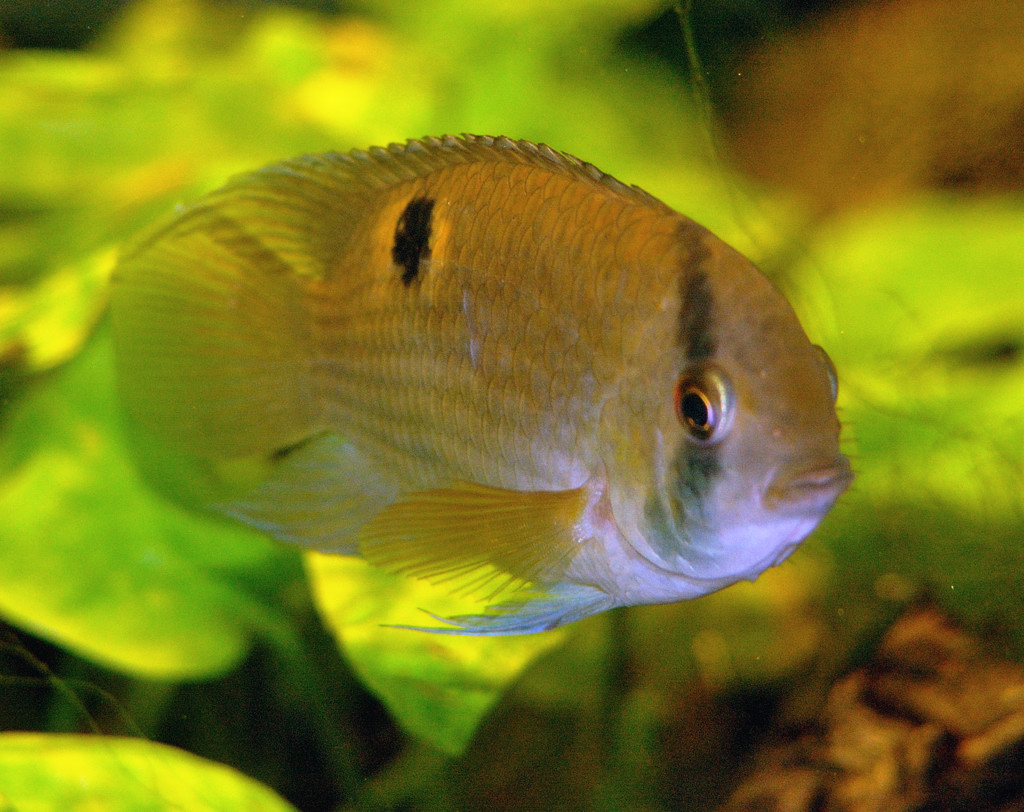The Keyhole cichlid, also known by its scientific name Cleithracara maronii, is a popular freshwater fish in the aquarium hobby. These fish are native to South America, specifically the Amazon Basin and the Rio Negro region, where they can be found in slow-moving waters with plenty of vegetation and leaf litter. Keyhole cichlids are peaceful and easy to care for, making them a great choice for beginner fishkeepers.
Physical Appearance
Keyhole cichlids are relatively small fish, growing to a maximum size of about 4-5 inches (10-12 cm) in length. They have a distinctive keyhole-shaped black marking on their sides, which gives them their common name. Their bodies are typically a light brown or gray color, and they have a black line running from their eye to their dorsal fin.
Males and females can be differentiated by their dorsal fin; the male’s dorsal fin will be longer and pointed, while the female’s will be shorter and more rounded. Males may also have more intense coloration and more pronounced markings than females.
Habitat and Tank Requirements
In the wild, Keyhole cichlids inhabit slow-moving waters with plenty of vegetation and leaf litter. In captivity, they should be provided with a similar environment. A tank of at least 30 gallons (114 liters) is recommended for a pair of Keyhole cichlids, with plenty of plants and hiding spots. They prefer slightly acidic water with a pH between 6.0 and 7.5, and a temperature range of 75-82°F (24-28°C).
Keyhole cichlids are peaceful fish that can be kept with other peaceful species. They may become aggressive during breeding, but this behavior is typically limited to chasing and posturing. They can be kept in pairs or small groups, but multiple males should not be kept together as they may become aggressive towards each other.
Diet
Keyhole cichlids are omnivorous and will eat a variety of foods. In the wild, they primarily feed on small insects, crustaceans, and plant matter. In captivity, they should be fed a diet of high-quality pellets or flakes, supplemented with occasional live or frozen foods such as brine shrimp, bloodworms, or daphnia.
Breeding
Breeding Keyhole cichlids is relatively easy and can be achieved in a well-maintained aquarium. They are monogamous and will form pairs. The male will typically choose a flat rock or leaf as a spawning site, where the female will lay her eggs. The male will then fertilize the eggs and guard the site.
The eggs will hatch after 2-3 days, and the fry will be free-swimming after another 5-7 days. The fry can be fed on freshly hatched brine shrimp or crushed flakes until they are large enough to eat larger foods.
Conclusion
Overall, Keyhole cichlids are a great choice for a peaceful community aquarium. They are easy to care for, have interesting behavior, and add a unique shape and coloration to any tank. With proper care, they can live for up to 10 years in captivity, making them a long-term investment for any fishkeeper.











![]()
